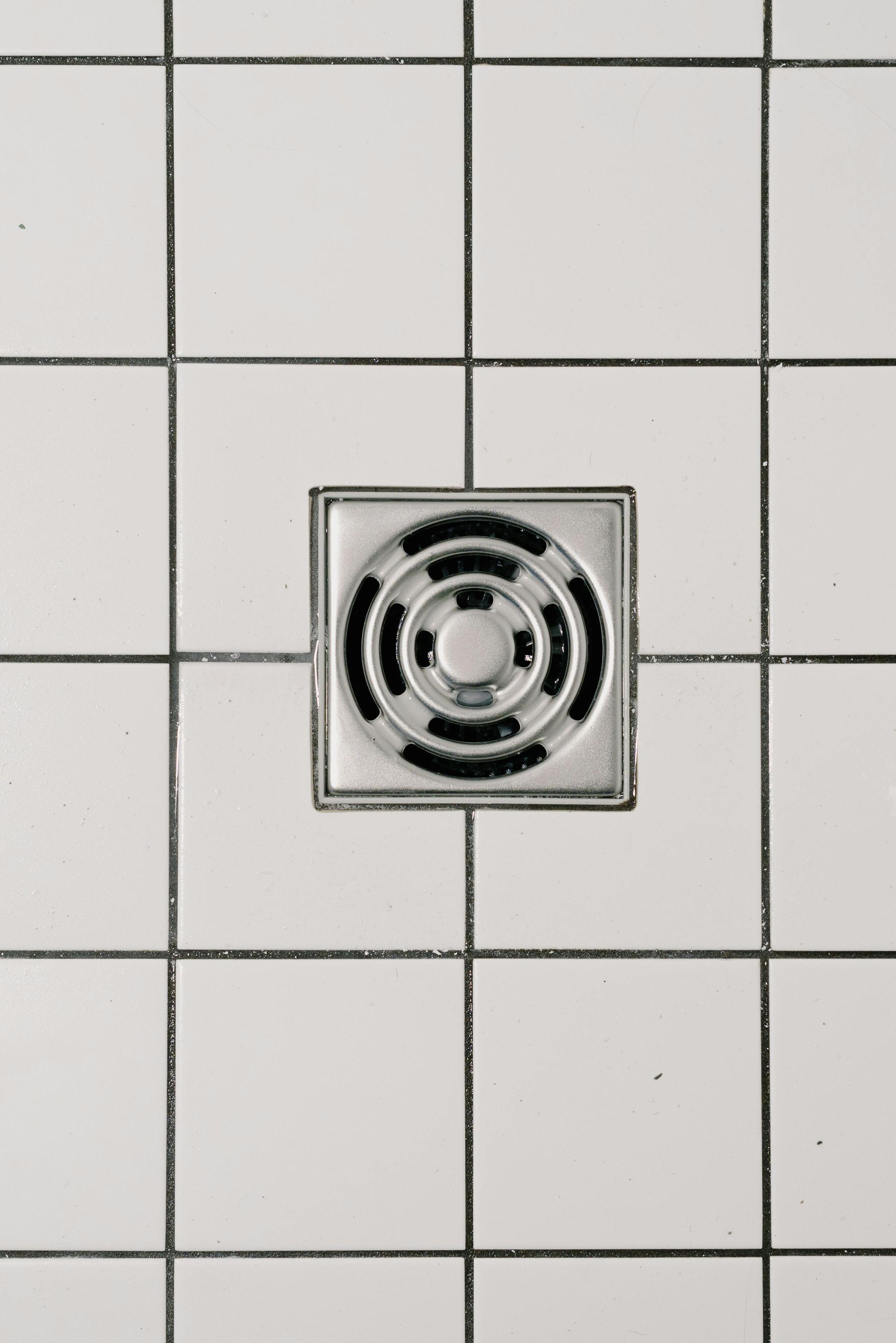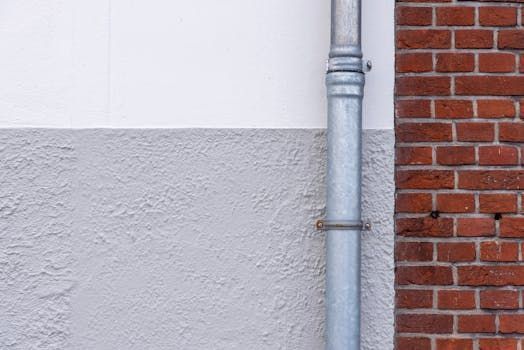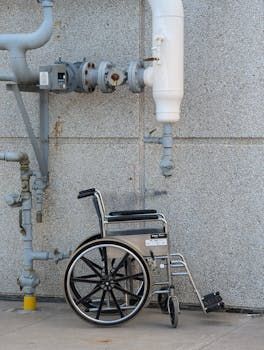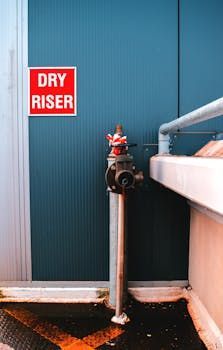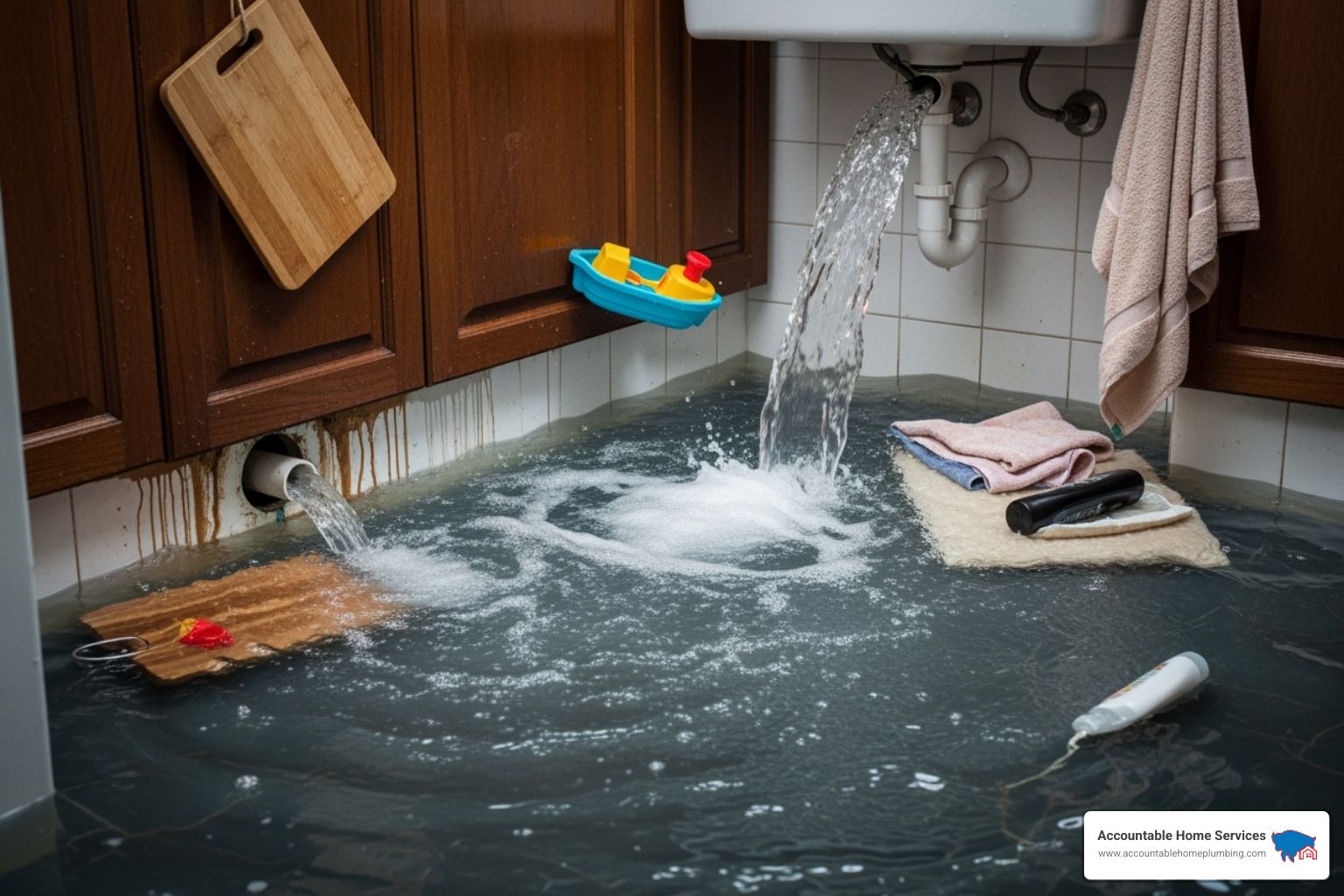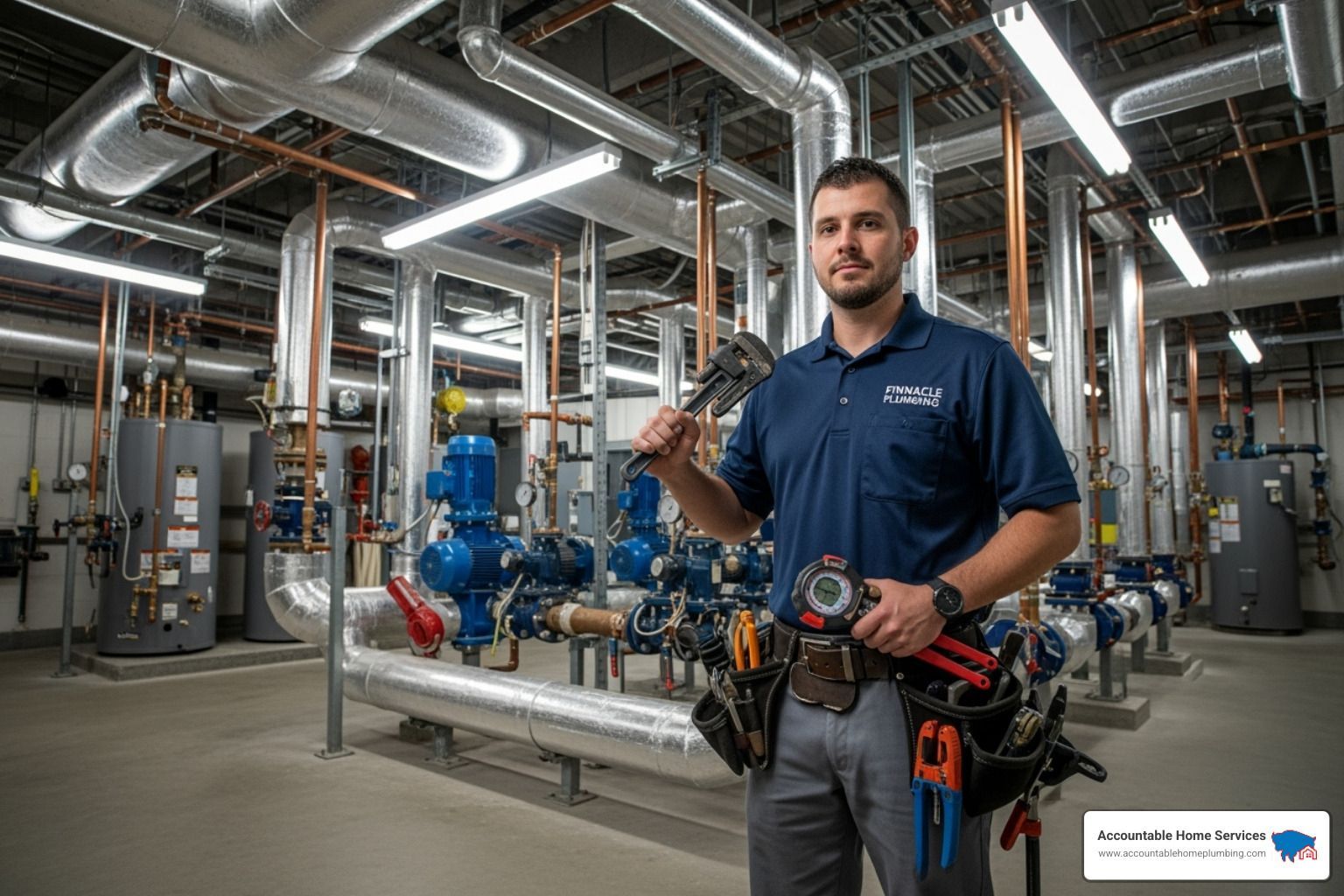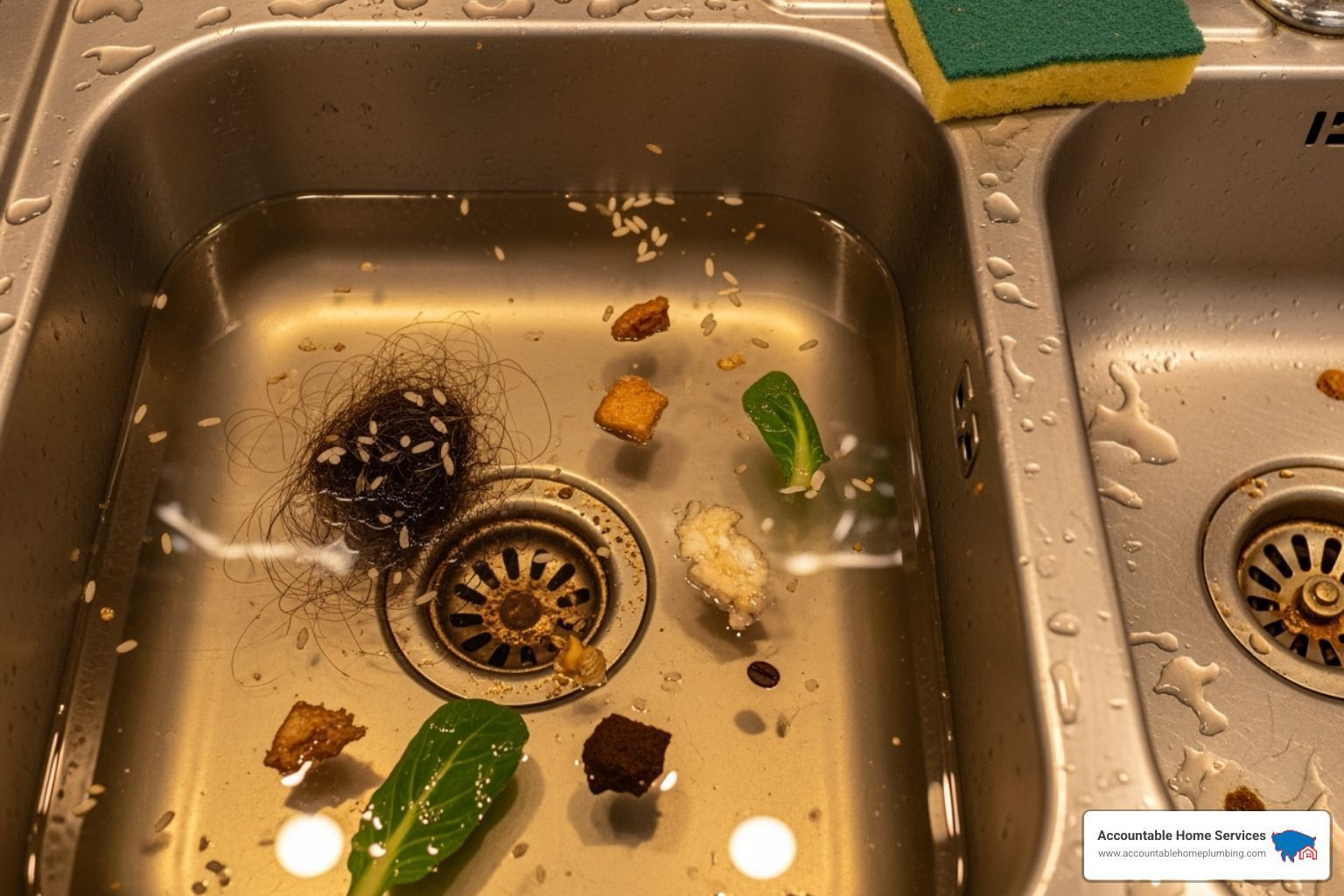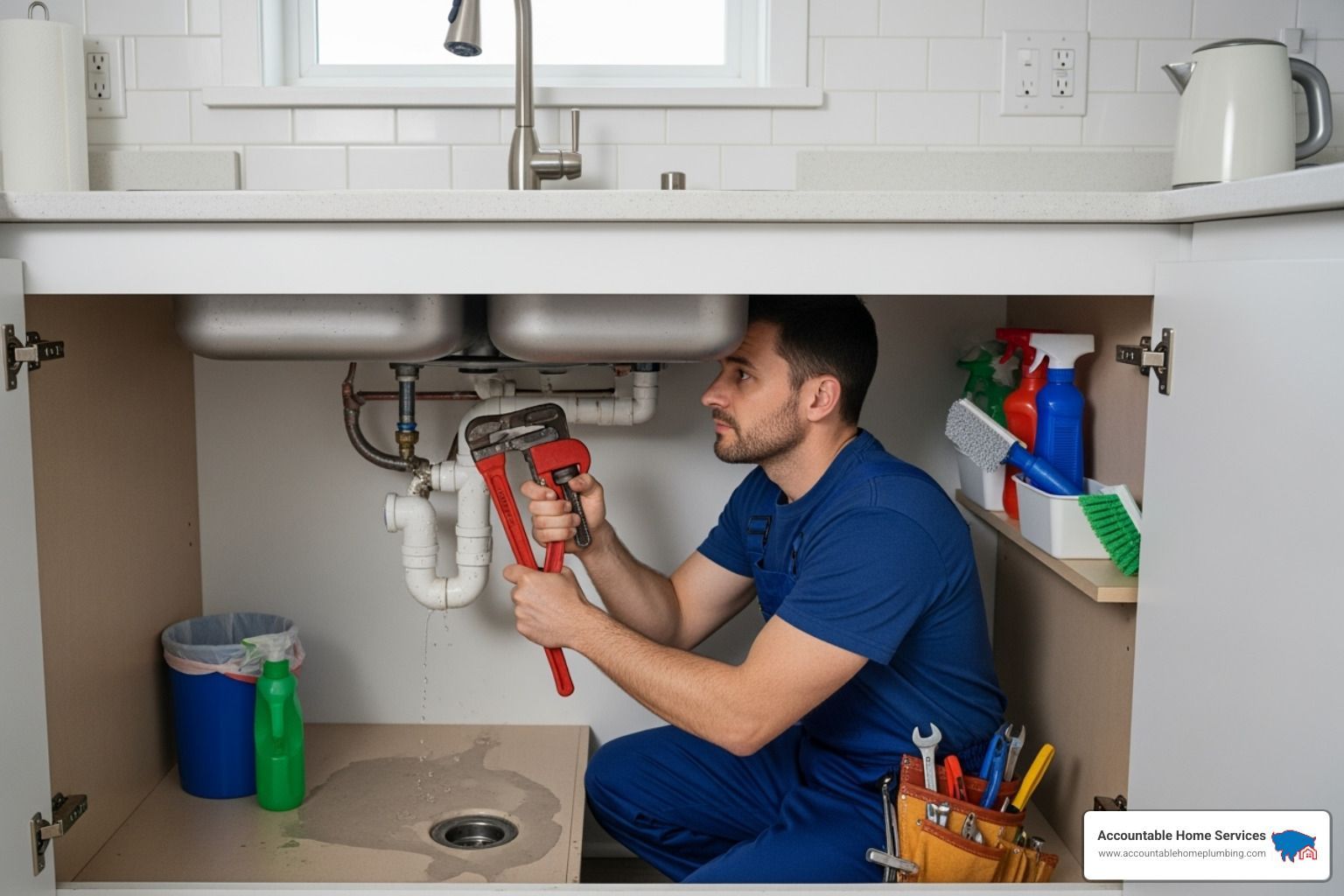No Tank, No Problem: Your Guide to Tankless Water Heater Hookup
Why Tankless Water Heater Installation Is Worth Understanding
Tankless water heater hookup involves connecting gas, water, and electrical lines to create an on-demand hot water system that can save homeowners up to $100 per year in energy costs. The process typically includes upgrading gas lines from 1/2" to 1" diameter, installing dedicated electrical circuits, and connecting direct-vent systems that require professional expertise to ensure safety and code compliance.
Essential Tankless Water Heater Hookup Steps:
- Gas Line Upgrade- Most installations require upgrading from 30k BTU/H to 90k-130k BTU/H capacity
- Electrical Connection- 240V dedicated circuit with 8-gauge wire for electric units
- Water Line Installation- Cold and hot water connections with isolation valves
- Venting System- Direct-vent piping through exterior walls (flue gases too cool for masonry chimneys)
- Pressure Relief Valve- Required safety component with proper discharge routing
- Testing & Commissioning- Leak testing, pressure testing, and system verification
Installing a tankless water heater is complex enough that most homeowners should hire a professional to handle gas, venting, and electrical upgrades. The average installation takes 3-4 hours and costs $2,600, but the units last 15-20 years compared to 10-15 years for traditional tanks.
As Mike Martinez, owner of Accountable Home Plumbing with years of experience in Denver's unique installation challenges, I've guided hundreds of homeowners through tankless water heater hookup decisions and installations. My team understands the local code requirements and gas line upgrades that make Denver-area tankless installations successful and safe.
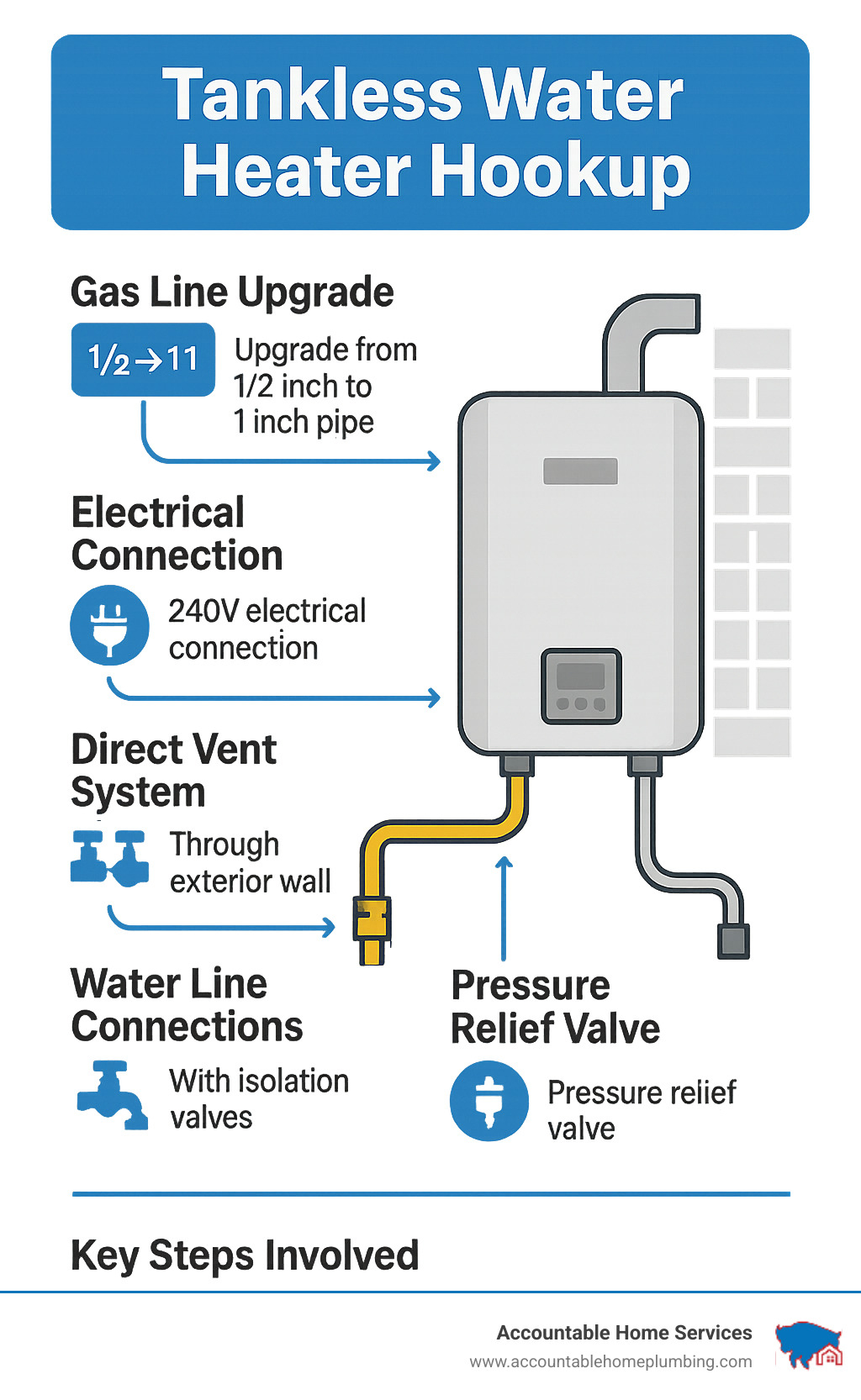
Understanding Tankless Water Heaters
Think of a tankless water heater as your personal hot water chef – it only starts cooking when you place an order. Instead of keeping a giant pot of water warm all day (like traditional tanks do), tankless units spring into action the moment you turn on a hot water tap.
A flow sensor detects water movement and instantly fires up the heating system. Cold water rushes through a heat exchanger where it gets heated to your perfect temperature before reaching your shower, sink, or dishwasher. No waiting, no reheating, no running out of hot water.
But here's the catch that affects every tankless water heater hookup – these units are energy powerhouses. While your old tank water heater sipped gas at around 30,000 BTU per hour, tankless units demand between 90,000 and 130,000 BTU per hour when they're working. That's why most installations require beefier gas lines.
You'll find tankless heaters in several flavors. Gas models run on natural gas or propane and need direct venting. Electric models work great for smaller applications but need serious electrical upgrades – we're talking 240V circuits. Condensing units squeeze extra efficiency out of exhaust gases, while non-condensing units cost less upfront.
The Uniform Energy Factor(UEF) tells you how efficient your unit will be. Higher numbers mean more savings. The Department of Energy found that tankless systems can slash energy use by up to 34% for typical households, potentially saving you up to $100 per year on energy costs.
How Does It Work?
When you twist that shower handle, cold water enters the unit and triggers the flow sensor. This sensor tells the heating system to wake up and get to work.
For gas units, this means igniting a powerful burner. Electric models energize heating elements that can draw as much power as an electric dryer. The water flows through the heat exchanger where it gets heated to your preset temperature, usually around 120°F.
Gas tankless units use a modulating burner, which adjusts its intensity based on how much hot water you need. Turn on just the bathroom sink, and it burns low. Fire up multiple fixtures, and it cranks up the BTU input to meet demand.
Advantages & Disadvantages
The endless hot water supply is the biggest game-changer. No more scheduling showers around the family's hot water usage. Tankless units are also space-saving champions – they mount on walls and free up valuable utility room real estate.
You'll love the longer lifespan too. While tank heaters typically give you 10-15 years of service, tankless units often last 15-20 years with proper maintenance. The energy efficiency comes from eliminating standby heat loss – you're not paying to keep 40-50 gallons of water hot when nobody's home.
But higher upfront costs can be a shock – tankless units typically cost twice as much as tank heaters, and that's before installation. The installation complexity often requires upgrading gas lines, electrical panels, and venting systems.
Flow rate limitations can be frustrating if you have a house full of teenagers who all want to shower simultaneously while the dishwasher runs. Don't forget about maintenance requirements either. In Denver's hard water areas, annual descaling becomes routine.
Sizing & Selecting the Right Unit
Getting the size right makes the difference between stepping into a refreshing hot shower and getting an unpleasant surprise. Tankless water heater hookup sizing isn't rocket science once you understand the two key numbers that matter.
Your sizing calculation starts with peak gallons per minute (GPM)- how much hot water your family uses when everyone's home and busy. A typical shower uses 1.25 to 2.5 GPM, while your kitchen faucet demands 1.5 to 2.2 GPM. Bathroom faucets are gentler at 0.5 to 1.5 GPM, but your dishwasher can pull 1 to 2.5 GPM and washing machines range from 1.5 to 3 GPM.
The second critical factor is temperature rise- how much your unit needs to heat the incoming water. Here in Denver, groundwater enters your home at a chilly 45 to 55°F. To reach a comfortable 120°F for your shower, you need a 65 to 75°F temperature rise.
| Household Size | Bathrooms | Typical BTU Requirement |
|---|---|---|
| 1-2 people | 1 bathroom | ~140,000 BTUs |
| 2-3 people | 2 bathrooms | ~190,000 BTUs |
| 3-5 people | 3 bathrooms | ~380,000 BTUs |
Colorado's high elevation and cold winters add another wrinkle to your calculations. That incoming water stays colder longer, and higher altitudes affect gas combustion, meaning you'll often need higher BTU inputs than coastal areas require.
For detailed cost breakdowns and installation estimates, check out our guide on How Much to Install On Demand Water Heater.
Calculating Flow Rate
The bucket test gives you real numbers instead of manufacturer estimates. Grab a one-gallon bucket and head to your shower. Turn the water on full blast and time how long it takes to fill the bucket. Divide 60 by that time, and you've got your actual GPM.
Map out your family's simultaneous usage patterns honestly. Maybe your teenagers never shower at the same time, but someone always seems to start the dishwasher right when you're washing dishes.
Oversizing slightly saves headaches later. If your math shows a 6 GPM peak demand, consider a unit rated for 7 to 8 GPM.
Choosing Fuel Type
Natural gas delivers the fastest heating response and lowest operating costs. The catch? Your existing gas line probably can't handle the increased demand. Most installations require upgrading from a 1/2-inch to 1-inch diameter gas line to supply the 90,000+ BTUs these units demand.
Gas units also need proper venting through exterior walls. Unlike traditional water heaters, tankless units produce flue gases too cool for masonry chimneys, requiring direct-vent systems.
Electric units work beautifully for point-of-use applications. For whole-house service, they demand serious electrical infrastructure. A typical whole-house electric tankless needs a 240V circuit with 100 to 200 amp capacity, which might mean upgrading your entire electrical panel.
Propane offers excellent performance if natural gas isn't available. Propane burns hotter than natural gas, allowing for more compact unit designs. The trade-offs include higher fuel costs per BTU and the ongoing need for tank refills.
Step-by-Step Tankless Water Heater Hookup
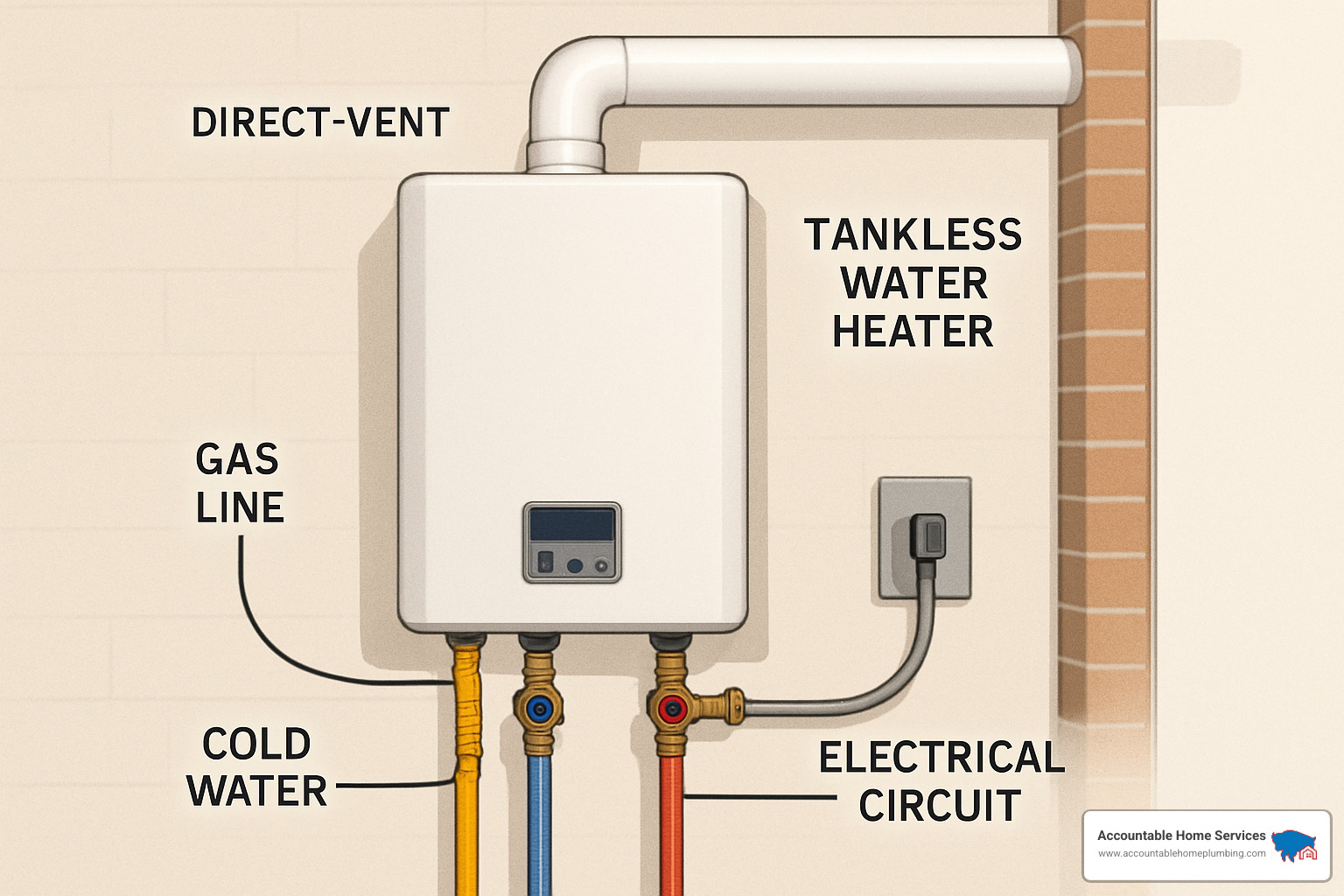
Tankless water heater hookup isn't exactly a weekend DIY project for most homeowners. Between gas lines carrying enough BTUs to power a small furnace, electrical circuits that could seriously hurt you, and venting systems that need to be perfect to avoid carbon monoxide issues, this is where calling professionals makes sense.
Understanding the process helps you make informed decisions and communicate effectively with your installer. The hookup process depends heavily on whether you're installing a gas or electric unit. Gas installations require dedicated gas lines, direct-vent systems, and electrical circuits for controls, while electric units focus mainly on high-voltage electrical work and water connections.
Gas Tankless Water Heater Hookup
Gas tankless water heater hookup starts with the reality that your existing gas line probably can't handle the job. Most homes have 1/2-inch gas lines designed for traditional water heaters using around 30,000 BTUs. Your new tankless unit will demand 90,000 to 130,000 BTUs when running, which means upgrading to a 1-inch gas pipe running from your meter to the heater location.
The mounting process requires finding a sturdy wall that can support the unit's weight plus the water it contains during operation. The heater needs to sit about 4 inches from the wall surface to allow proper airflow and service access.
Water line connections involve installing water isolation valves on both the cold inlet and hot outlet sides. These valves make future maintenance much easier. The connections typically use copper pipe or approved flexible connectors, with every joint properly sealed to prevent leaks.
The venting system represents the most critical safety component. Gas tankless units produce flue gases that are too cool for traditional chimneys, so they need direct-vent systems that pipe exhaust directly through an exterior wall. Getting the slope right is crucial because condensing units produce significant amounts of water that must drain properly.
Even gas units need electrical connections for their ignition systems and digital controls. This usually means running a dedicated 15-amp circuit from your electrical panel to the heater location. Finally, every installation requires a pressure relief valve with a discharge line that routes safely to a floor drain or exterior location.
For homeowners considering outdoor installations, our guide on outdoor tankless water heater installation covers the unique considerations for external mounting.
Electric Tankless Water Heater Hookup
Electric tankless water heater hookup eliminates the gas line and venting complexity but introduces serious electrical demands. Whole-house electric tankless units typically require 240-volt breakers with 100 to 200 amp capacity, which may mean upgrading your entire electrical panel in older homes.
The electrical installation uses 8-gauge armored cable running from a dedicated circuit breaker to the unit location. GFCI protection may be required depending on your local codes and the installation location.
Mounting electric units offers more flexibility since there's no venting to consider. Wall mounting requires solid support but without the clearance requirements for combustion air.
Water connections follow the same principles as gas units, using isolation valves for maintenance access. The key difference is that electric units can be installed almost anywhere with adequate electrical service.
Common Mistakes to Avoid
The biggest mistake we see is undersized gas lines- trying to use existing 1/2-inch pipe for units that need much larger capacity. This creates insufficient gas pressure and poor performance.
Improper vent slope causes condensate problems in gas units. The water produced during combustion must drain properly, or it backs up into the unit and causes expensive damage.
Many DIYers skip the pressure test on gas lines. Professional installers use a pressure test gauge to verify that all connections can safely handle operating pressures before turning on the gas.
Warranty-void DIY wiring represents another expensive mistake. Most manufacturers require professional electrical installation to maintain warranty coverage.
Testing, Safety & Code Compliance
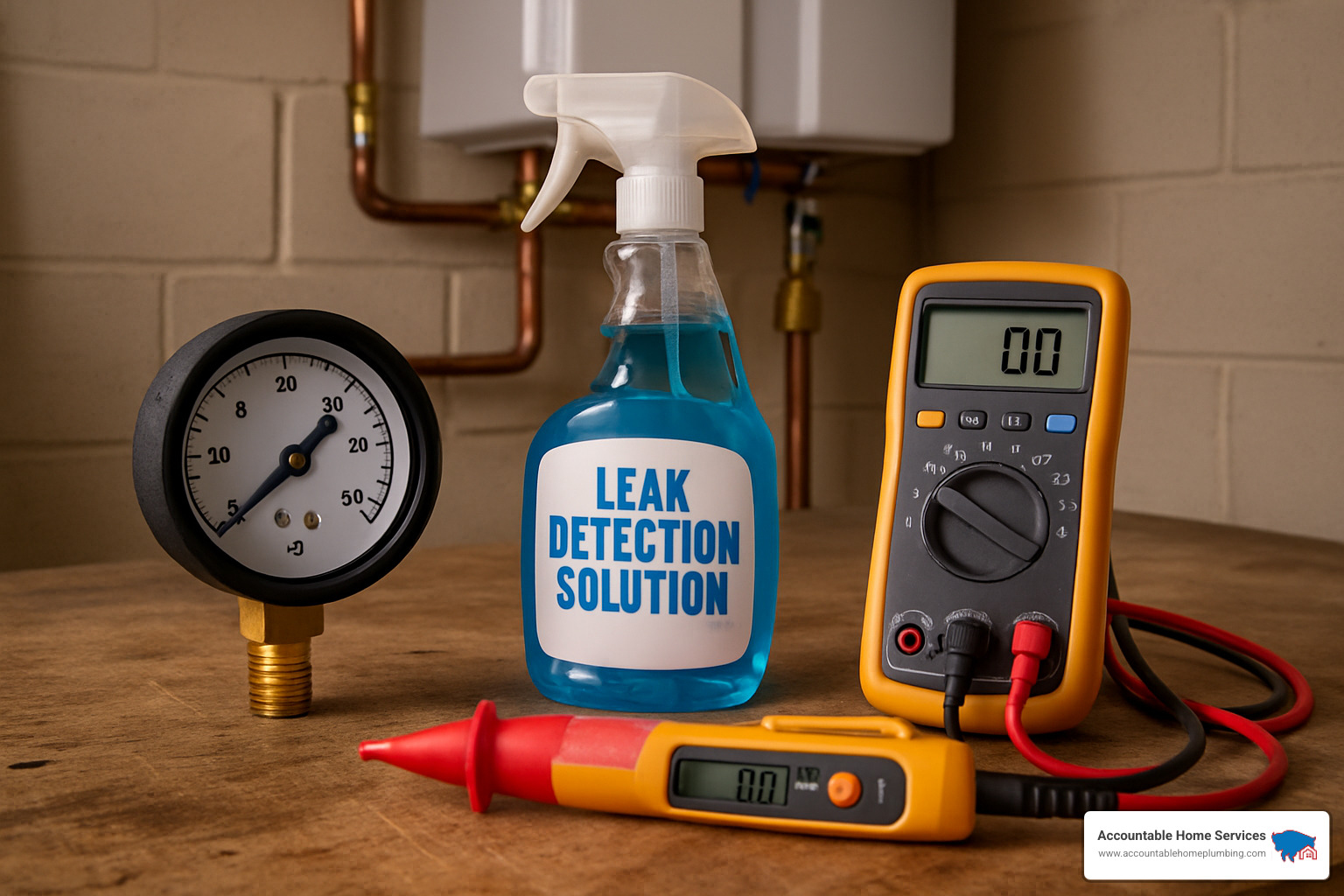
Testing your tankless water heater hookup properly isn't just about making sure everything works—it's about keeping your family safe and avoiding expensive problems down the road.
Gas leak detection should be your first priority after completing any gas connections. Mix up some leak detection soap solution and apply it generously to every joint, fitting, and connection. You're looking for any bubbling that signals escaping gas. Never use a lighter or match to check for gas leaks.
Water leak testing comes next. Turn on your water supply and carefully inspect every connection point. Soldered joints and threaded connections are the most common trouble spots. A small drip today can become a major flood tomorrow.
For electrical testing, verify that you're getting proper voltage at the unit and double-check that all connections are tight and secure. If you've installed GFCI protection, test those devices to make sure they're working correctly.
Combustion air clearance matters more than many people realize. Your gas tankless unit needs adequate fresh air to burn safely and efficiently. Check that all combustion air intakes are clear of debris, snow, or other obstructions.
Code compliance varies significantly across the Denver metro area. Most cities including Denver, Boulder, Arvada, Westminster, Thornton, Northglenn, Broomfield, and Longmont require permits for tankless installations. Permit fees are much cheaper than having to redo work that doesn't meet code.
Your installation must meet ANSI Z21.10.3 and CSA 4.3 standards for gas appliances, plus all National Electrical Code requirements for any electrical work. These are proven safety standards developed over decades of real-world experience.
If you're working with a professional installer, they can help you Search here to find a Bradford White professional in your area who knows local codes inside and out.
Start-Up Checklist
Before you fire up your new tankless unit, verify everything is ready. Confirm all utilities are properly connected and that your gas pressure meets the manufacturer's specifications. Check that your water pressure and flow rates are adequate, and make sure all electrical connections are secure and properly grounded.
The initial start-up process begins with purging air from your water lines. Open several hot water taps throughout your home and let them run until you get steady water flow without sputtering.
Turn on your gas supply and electrical power, then set the temperature to 120°F. This temperature provides comfortable hot water while minimizing scalding risk and energy waste. Test the unit by running hot water at multiple fixtures—you should hear the unit ignite and see consistent water temperature.
Check for error codes on the display panel. Modern tankless units are smart enough to tell you when something's wrong. Write down the serial number and installation date for warranty purposes.
Your final testing should include running multiple fixtures simultaneously to verify your unit can handle peak demand. Check that water temperature stays consistent even when flow rates change, and make sure your venting system is drafting properly.
Maintenance & Long-Term Savings
Think of your tankless water heater like a high-performance car - it'll run beautifully for years if you take care of it, but neglect it and you'll face expensive repairs. Tankless water heater hookup investments pay dividends through lower energy bills and longer equipment life when properly maintained.
Annual descaling tops the maintenance priority list, especially here in the Denver metro where hard water loves to leave mineral deposits. These calcium and lime buildups act like insulation inside your heat exchanger, forcing the unit to work harder and reducing efficiency. Use only NSF/ANSI 60 certified descaling solutions.
The descaling process involves connecting a small circulation pump to your unit's service valves and running the cleaning solution through the system for about an hour.
Inlet filter cleaning takes just five minutes every few months but prevents thousands of dollars in damage. This little screen catches debris before it reaches sensitive internal parts. Simply unscrew it, rinse under cold water, and reinstall.
Combustion air filters on gas units need attention too, especially during Colorado's dusty seasons. A clogged filter forces your unit to work harder and can cause premature failure. Check it monthly during winter when your heater works overtime.
Don't forget your venting system inspection. Birds love to build nests in vent terminations, and debris can block proper airflow. A quick annual check prevents expensive service calls and keeps your unit running safely.
The math works in your favor with proper maintenance. Well-maintained tankless units deliver 30-50% lower operating costs than traditional tanks and last 15-20 years compared to tanks' 10-15 year lifespan.
Many utility companies and manufacturers offer rebate programs that can offset maintenance costs. Check with Xcel Energy and your unit's manufacturer for current incentives.
For detailed maintenance guidance, check out our comprehensive resource: More info about Routine Water Heater Maintenance.
DIY Upkeep vs Pro Service
Some maintenance tasks are perfect weekend projects, while others require professional expertise to keep your warranty intact and your family safe.
DIY-friendly tasks include cleaning inlet filters, wiping down the exterior, monitoring error codes on the display, and keeping maintenance records. These simple steps take minimal time but make a big difference in performance.
Professional service becomes essential for annual descaling in hard water areas, gas line inspections, electrical system testing, and comprehensive venting system cleaning. Many manufacturers actually require professional maintenance to maintain warranty coverage.
Keep detailed records of all maintenance activities, whether DIY or professional. Use only approved descaling solutions and follow manufacturer procedures exactly.
Frequently Asked Questions about Tankless Water Heater Hookup
How do I know my home's gas line or electrical panel is adequate?
Your existing gas line probably isn't ready for a tankless water heater hookup if you have standard 1/2" pipes. Most homes were built with gas lines sized for traditional tank water heaters that use around 30,000 BTUs per hour. Tankless units demand 90,000 to 130,000 BTUs when they're firing up.
For gas systems, you'll need to calculate your total BTU demand including your furnace, existing water heater, and any other gas appliances. Most installations require upgrading to 1" black iron pipe from the meter to the tankless unit location. A licensed plumber should perform a proper gas load calculation to determine exactly what your home needs.
Electric systems are even more demanding on your home's infrastructure. A whole-house electric tankless unit typically needs 100-200 amps of dedicated capacity. If your home has a 200-amp main panel that's already serving a lot of circuits, you'll likely need a panel upgrade.
Point-of-use electric units are more manageable, requiring dedicated 240V circuits with amperage matching the specific unit's requirements. Even these smaller units often need 30-60 amp circuits, which is substantial electrical work.
A qualified contractor can assess your home's capacity during a consultation and explain exactly what upgrades you'll need before starting the project.
Can I install a tankless unit myself without voiding the warranty?
The short answer is no - and there are several important reasons why professional installation protects your investment. Most manufacturers require professional installation by licensed contractors to maintain warranty coverage.
Gas work must be performed by licensed plumbers in most jurisdictions, and electrical work requires licensed electricians. These requirements exist because gas and high-voltage electrical work can be dangerous when done incorrectly.
Tankless installations involve complexities that go beyond basic skills. Gas line sizing calculations, BTU load analysis, proper venting design, and code compliance requirements make this a job for professionals who do this work regularly.
DIY installation typically voids manufacturer warranties and may violate local building codes, potentially creating problems when you sell your home or file insurance claims. The cost of professional installation is usually offset by warranty protection, proper system performance, and peace of mind.
What venting rules apply inside Denver city limits?
Denver and surrounding municipalities have specific requirements that make tankless water heater hookup more complex than in some other areas. All tankless water heaters require direct-vent systems- you cannot use traditional masonry chimneys because tankless units produce flue gases that are too cool to create proper draft.
Vent terminations must maintain specific clearances from windows, doors, air intakes, and property lines. Generally, you need at least 3 feet from any opening that could allow exhaust gases to enter the home, and 10 feet from any air intake for HVAC systems.
Vent pipes must be properly sloped for condensate drainage, and the termination must be positioned to prevent recirculation of exhaust gases. In windy areas like the Front Range, proper termination design becomes even more critical.
Most Denver metro municipalities require permits for tankless installations, and inspections verify proper venting, gas line sizing, and electrical work. Each city has slightly different requirements.
Contact your local building department for specific requirements in your area. Professional installers who work regularly in your area stay current on local codes and can steer the permit process efficiently.
Conclusion
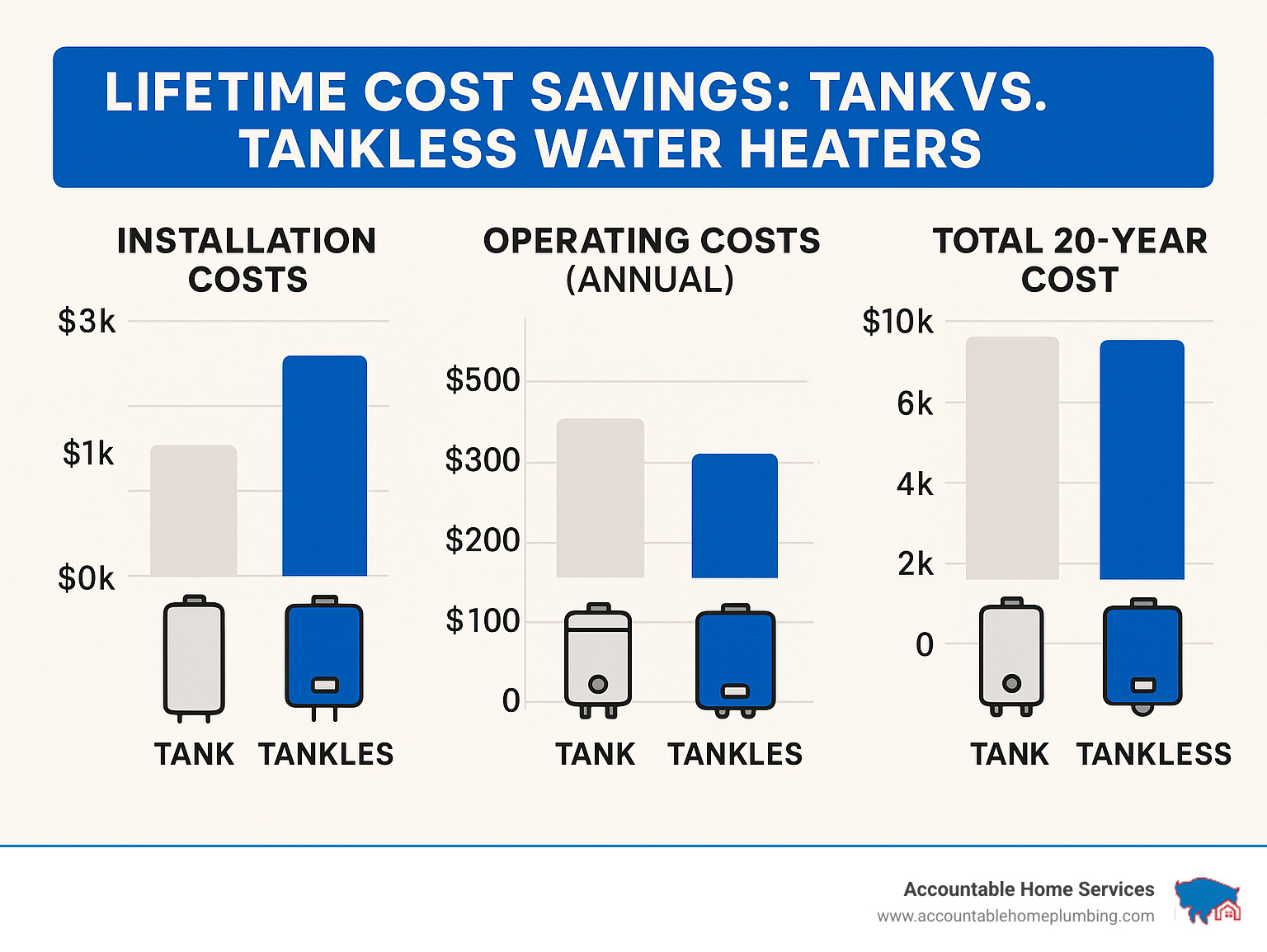
Making the switch to a tankless water heater isn't just about upgrading your plumbing - it's about changing how your family experiences hot water every day. No more cold surprises in the middle of a shower, no more waiting for the tank to reheat after someone else's long bath, and no more bulky tank taking up precious space in your utility room.
The tankless water heater hookup process might seem daunting with all the gas line upgrades, electrical work, and venting requirements we've covered. But here's the reality: when done right by experienced professionals, this installation delivers endless hot water for 15-20 years while cutting your water heating costs by up to $100 annually.
Think about it this way - over the lifetime of your tankless unit, you'll save thousands in energy costs while enjoying the convenience of never running out of hot water. The higher upfront investment pays for itself through lower operating costs, longer lifespan, and increased home value.
The key to success lies in getting the details right from day one. Proper sizing ensures adequate flow rates during peak demand. Correct gas line sizing prevents performance problems that frustrate homeowners for years. Professional venting installation keeps your family safe and meets local codes.
At Accountable Home Plumbing, we've guided hundreds of Denver-area families through tankless installations that actually work as promised. We handle the complex gas line upgrades, electrical connections, and direct-vent systems that make or break these installations. Most importantly, we provide upfront pricing so you know exactly what to expect - no surprises, no hidden fees.
Whether you're tired of running out of hot water during busy mornings or simply want to free up space and reduce energy bills, a properly installed tankless system delivers the seamless hot water experience you're looking for.
Ready to explore how tankless technology can work in your home? We'll assess your current setup, explain your options clearly, and provide transparent pricing for the complete installation. For detailed information about our installation services, visit: More info about Water Heater Installation.

